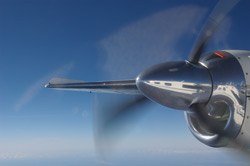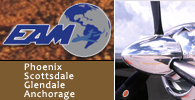Winter OPS and Commander Ice Protection Systems

By Hugh Davis

Anti-ice protection includes bleed-air-heated engine inlets�the smile, and
electrically heated generator cooling inlet (top of engine) and propeller boots.
In most cases, your Turbo Commander was delivered to its original owner with fully operable and certified anti- and deicing systems. Standard equipment for the 690 was an anti-icing system that provided heat to the pitot, fuel vents, alternate static, and stall vane. The remaining equipment needed to perform in icing conditions was an option. On all the remaining Turbo Commander models (690A through the JetProp 1000) standard equipment included deice and anti-ice equipment to fly into known or forecasted icing conditions.
System knowledge of the deicing and anti-ice systems is the first step in managing the risks of icing conditions. Two separate subsystems combine to prevent and eliminate ice accumulation on the aircraft while in flight. The anti-ice system is electrically activated to provide heat in critical areas such as the rudder slot, rudder trim tab, generator cooling inlets, windshields, pitot-static systems, stall warning vane, and fuel vents. The engine inlet is anti-iced by bleed air. The 690 is the only model to use an alcohol spray nozzle system for pilot�s-side windshield anti-ice. All others in the Commander series have electrically heated windshields. The deice system consists of leading-edge boots that are pneumatically inflated using regulated engine bleed air, and electrically heated propeller boots.
TRY BEFORE YOU FLY
During normal fair-weather operations it is good practice to check the anti-ice and deice systems for normal operation. The POH and the FAA require that the systems be checked prior to flight into forecasted icing conditions. When checking the anti-icing systems, limit ground checks to 5 seconds �ON� if the outside air temperature is above 5 degrees C. When checking the deice boots on the ground, ensure the vacuum system has deflated the boots before takeoff.
During all flights it is a good practice to keep abreast of the current and forecasted weather conditions. Checking with Flight Service, Flight Watch, or downloading the latest datalink weather will help you make good aeronautical decisions concerning icing conditions ahead of your flight. Listening on the frequency to what other pilots are saying about the weather will help you decide that it may be necessary to turn on the anti-ice systems. Sometimes it is prudent to deviate due to icing conditions, just as is the case when operating near thunderstorms.
In 1999, the FAA issued an Airworthiness Directive (AD 99-19-18) that mandated revisions to the AFM/POH to advise flight crews to activate airframe pneumatic deicing boots at the first sign of ice accumulation. The AD also requires limiting the use of the autopilot. Whenever icing conditions are encountered aircraft performance will deteriorate. Weight and drag increase, reducing range, increasing fuel requirements, and reducing the service ceiling. As two recent icing accidents demonstrated, a Turbo Commander carrying ice will stall at a higher airspeed, sometimes as much as 50 knots higher.
LONGER LANDINGS
During approach and landing, if it appears that the normal power settings are not enough to maintain level flight or the proper airspeed on descent, it could mean the aircraft is affected by the weight or the drag of the ice. Increased airspeeds will also influence the landing distance, sometimes as much as 200 percent.
Other items to consider during winter operations are ground deicing procedures, contaminated runways, hydroplaning, the use of engine ignition during takeoff and landing, and especially the comfort of the crew and passengers.
Note: As I write this the temperature here in Houston is in the 95-100 degree range, the humidity is near 100 percent, and it has been raining for several days. Flying in icing conditions is probably the last thing I think about at this time of year. However, in August 2009 I was flying a Commander 690B over southern New Mexico when I encountered the most amount of ice I have seen in years. The deice system was just keeping up to remove the one-half-inch accumulations. The one salvation I had was that it was warmer at lower altitudes, and as I descended all the ice melted away.
Hugh Davis in an instructor in FlightSafety International�s Twin Commander program at its Houston Hobby Center.
Discuss this article in the forums...







